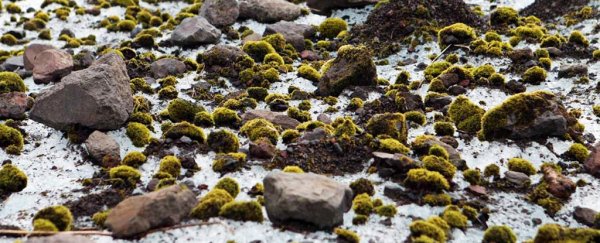For decades, scientists have been intrigued and captivated by small, fuzzy balls of moss that slowly make their way across Arctic glaciers. Now we know more about how these 'glacier mice' are travelling together.
While several reports have been filed observing these mossy balls, so far very little research has been done into how they move and how they develop – information that's useful not least because these rolling clumps are home to a variety of invertebrate life.
To try to get some answers, a new study analysed 30 of the strange glacier mice on the Root Glacier in Alaska, using bracelets of beads to measure the movements of the balls across a period of four years.
"These ovoid-shaped conglomerations of dirt and moss are only found on some glacier surfaces and provide key habitats for invertebrate colonisation," write the researchers in their published paper.
"Yet, despite their development and presence being widely reported, no studies of their movement and persistence across years have been conducted."
It's friday at the end of the semester.
— Tim Bartholomaus (@TimBartholomaus) May 15, 2020
That means it's time to ponder one of the great, enduring mysteries of cryospheric science and ecology: What controls the herd-like, coordinated, motion of glacier moss balls?
Just published: https://t.co/tHPJbjIlLv pic.twitter.com/m5ZzD9GTa0
It's thought that the mossy mice get their start from small rocks or other impurities in the ice, which causes the build up of different types of moss and sediment.
While these moss balls have been found on a small number of glaciers across the world, it seems they need an as-yet-unknown set of environmental conditions to start forming.
While previous research had established that the glacier mice moved and rolled around – probably so every side could see life-giving sunlight – the new study shows that the clumps actually move together in specific directions.
Not that this movement is particularly fast: the group of 30 glacier mice were recorded as moving at an average of 2.5 centimetres (almost 1 inch) a day. Wherever they're going, they're not in any rush, but the movement is somehow coordinated.
"The whole colony of moss balls, this whole grouping, moves at about the same speeds and in the same directions," glaciologist Tim Bartholomaus, from the University of Idaho, told Nell Greenfieldboyce at NPR. "Those speeds and directions can change over the course of weeks."
"By coming back year after year, we could figure out that these individual moss balls were living at least, you know, five, six years and potentially much, much longer."
Here are some more photos of these charismatic, glacier megafauna pic.twitter.com/ITphRRDd6C
— Tim Bartholomaus (@TimBartholomaus) May 15, 2020
With moss balls one of very few sources of nutrients for invertebrate organisms such as springtails, tardigrades, and nematodes on a glacier, scientists are understandably keen to try and learn more about how they function and the forces that affect them.
And while the latest study answers some questions – the glacier mice movement doesn't appear to be random – it raises up a few more of its own, such as why these clumps travel in the same direction for a while before changing direction again.
Through measurements of the glacier itself, the researchers established that it wasn't due to the slope of the ice, or the prevailing winds, or the patterns of sunlight. There's some as-yet-unseen force directing these glacier mice where to go – and that could be the perfect mystery for future study.
"We could not explain the direction of moss ball movement by considering the physical surface of the glacier (i.e., the downslope direction), the intensity of glacier ice ablation, and patterns of solar radiation," conclude the researchers.
"Thus, it appears a still unknown external force influences glacier moss ball movement on the Root Glacier."
The research has been published in Polar Biology.
